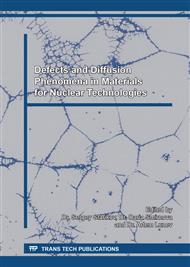[1]
M.R. Tonks, D. Andersson, S.R. Phillpot, Y. Zhang, R. Williamson, C.R. Stanek, B.P. Uberuaga, S.L. Hayes, Mechanistic materials modeling for nuclear fuel performance, Annals of nuclear energy 105 (2017) 11-24.
DOI: 10.1016/j.anucene.2017.03.005
Google Scholar
[2]
H.L. Yang, Y. Matsukawa, S. Kano, Z.G. Duan, K. Murakami, H. Abe, Investigation on microstructural evolution and hardening mechanism in dilute Zr-Nb binary alloys, Journal of Nuclear Materials 481 (2016) 117-124.
DOI: 10.1016/j.jnucmat.2016.09.016
Google Scholar
[3]
D. Khatamian, Solubility and partitioning of hydrogen in metastable Zr-based alloys used in the nuclear industry, Journal of Alloys and Compounds 293–295 (1999) 893–899.
DOI: 10.1016/s0925-8388(99)00388-6
Google Scholar
[4]
R. Montgomery, C. Tomé, W. Liu, A. Alankar, G. Subramaniane, C. Stanek, Use of multiscale zirconium alloy deformation models in nuclear fuel behavior analysis, Journal of Computational Physics 328 (2017) 278–300.
DOI: 10.1016/j.jcp.2016.09.051
Google Scholar
[5]
D.E. Smirnova, S.V. Starikov, An interatomic potential for simulation of Zr-Nb system, Computational Materials Science 129 (2017) 259–272.
DOI: 10.1016/j.commatsci.2016.12.016
Google Scholar
[6]
G.S. Was, J.P. Wharry, B. Frisbie, B.D. Wirth, D. Morgan, J.D. Tucker, T.R. Allen, Assessment of radiation-induced segregation mechanisms in austenitic and ferritic–martensitic alloys, Journal of Nuclear Materials 411 (2011) 41-50.
DOI: 10.1016/j.jnucmat.2011.01.031
Google Scholar
[7]
S. Plimpton, Fast Parallel Algorithms for Short-Range Molecular Dynamics, J Comp Phys, 117 (1995) 1-19.
Google Scholar
[8]
J. Li, Modelling Simul. Mater. Sci. Eng. 11 (2003) 173.
Google Scholar
[9]
J. Horváth, F. Dyment, H. Mehrer, Anomalous self-diffusion in a single crystal of alpha-zirconium, Journal of Nuclear Materials 126 (3) (1984) 206–214.
DOI: 10.1016/0022-3115(84)90030-8
Google Scholar
[10]
G.M. Hood, H. Zhou, R.J. Schultz, N. Matsuura, J.A. Roy, J.A. Jackman, Self- and Hf diffusion in a-Zr and in dilute, Fe-free Zr(Ti) and Zr(Nb) alloys, Defect Diffus. Forum 143–147 (1997) 49–54.
DOI: 10.4028/www.scientific.net/ddf.143-147.49
Google Scholar
[11]
T. Lundy, Diffusion in body-centered cubic metals zirconium, vanadium, niobium, and tantalum (thesis), report ORNL-3617 (1964), Tech. rep.
DOI: 10.2172/4059601
Google Scholar
[12]
M.I. Mendelev, B.S. Bokstein, Molecular dynamics study of selfdiffusion in Zr, Phil. Mag. 90 (5) (2010) 637.
Google Scholar
[13]
G. Kresse, J. Furthmüller, Efficient iterative schemes for ab initio total-energy calculations using a plane-wave basis set, Phys. Rev. B. 54 (16) (1996) 11169.
DOI: 10.1103/physrevb.54.11169
Google Scholar
[14]
H.J. Monkhorst, J.D. Pack, Special points for brillouin-zone integrations, Phys. Rev. B 13 (1976) 5188–5192.
DOI: 10.1103/physrevb.13.5188
Google Scholar
[15]
G. Kresse, D. Joubert, From ultrasoft pseudopotentials to the projectoraugmented wave method, Phys. Rev. B 59 (3) (1999) 1758–1775.
DOI: 10.1103/physrevb.59.1758
Google Scholar
[16]
C. Domain, Ab initio modelling of defect properties with substitutional and interstitials elements in steels and Zr alloys, Journal of Nuclear Materials 351 (2006) 1–19.
DOI: 10.1016/j.jnucmat.2006.02.025
Google Scholar
[17]
A. Seko, S.R. Nishitani, I. Tanaka, H. Adachi, E.F. Fujita, First-principles calculation on free energy of precipitate nucleation, Computer Coupling of Phase Diagrams and Thermochemistry 28 (2004) 173–176.
DOI: 10.1016/j.calphad.2004.07.003
Google Scholar


